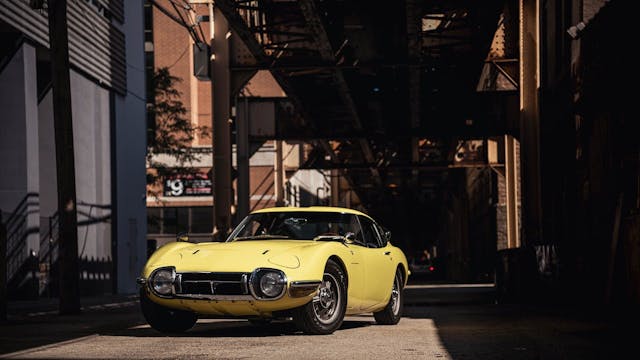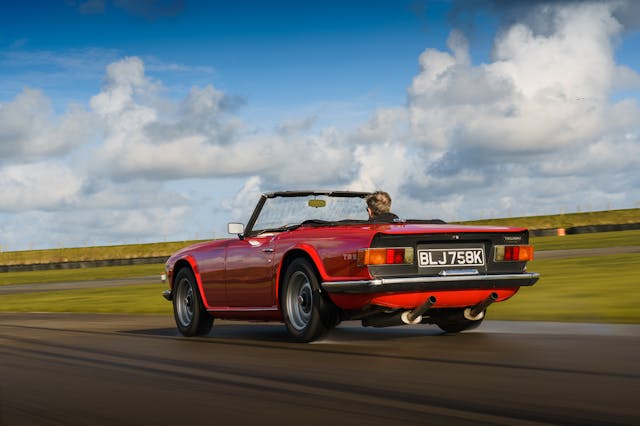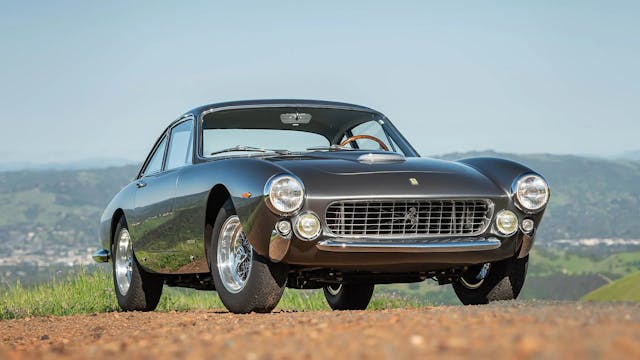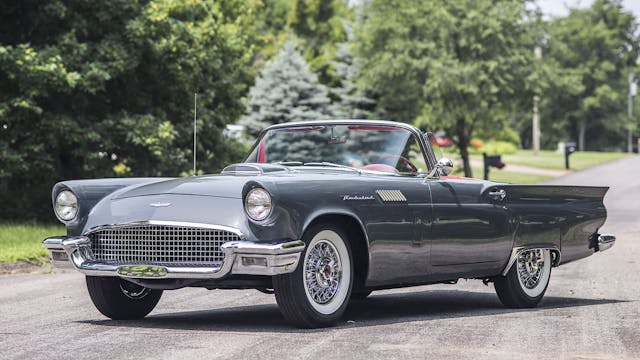Media | Articles
Sometimes No News Is Good News, Even in Collector Cars
Financial news is driven by changes. You don’t often see a notification flash on to your phone stating, “Breaking: nothing is different.” Given how dynamic the collector car market was from 2020 through 2022, though, watching the market settle into mostly small and measured changes is indeed newsworthy. This market slow-down, on which we have reported extensively, is confirmed in the latest Hagerty collector car index update.
Out of our seven primary indexes, five remained unchanged and two dropped in value. Those downward moves were modest, with the largest being a three percent drop by our Affordable Classics Index. Less volatile values may be a negative for speculators, but they are generally a good thing for enthusiasts. Market stability means price changes are more gradual and predictable, and buyers can take time to consider a purchase without fear of being priced out of a car.
The collector car market, like any other, is nuanced. These indexes track overarching trends of broad segments of cars, but the performance of individual vehicles can be exaggerated or run counter to the indexes of which they are a part. But at a high level, price changes in the collector car market seem to be paused for now.
Blue Chip Index
The Hagerty “Blue Chip” Index of the Automotive A-List is a stock market–style index that averages the values of 25 of the most sought-after collectible automobiles of the post-war era.

Much as the broader collector car market continues a lengthy slowdown, so do the upper edges of the market. Hagety’s Blue Chip index remained unchanged over the last quarter of 2023, which is the third consecutive quarter of static performance. It is now ten percent higher than it was three years ago, which may be a smaller increase than many observers would guess, and it is only one percent higher than it was in 2019.
At an individual level, four of the index’s 25 cars increased in value, with the Toyota 2000GT being the only car to grow by more than three percent (it moved ahead by a meaningful six percent). The BMW 507 was the only car in the group to lose value last quarter, slipping by four percent to $2.2M.
The pandemic didn’t prompt blue chip cars to soar like cars from more affordable segments. Instead, it reversed a downward slide that began in 2018, bringing more modest and measured gains to this group. As buyers become increasingly selective, those watching the market should look for blue chip cars to either continue to hold or to appreciate slightly. These cars, after all, have a long history of desirability across ages and geography, which will appeal to those who are risk-averse and looking for a premier car to tour and enjoy.
British Index
The Hagerty Index of British Cars is a stock market–style index that averages the values of ten of the most iconic British sports cars from the 1950s through the 70s.

For seven consecutive quarters, Hagerty’s British Car Index hasn’t seen more than a one percent change either up or down, with the index staying unchanged in the most recent period. The group currently sits at the same level it last had in both September 2021 and September 2019, showing how this segment has oscillated within a range rather than trending in any one direction.
That said, there is still quite a bit of movement underneath the surface. Of this index’s ten component cars, six fell in value and two grew. The steepest hit was to the Triumph TR6 (which dropped 15 percent since October 2023), followed by the MGA 1600 roadster (which slipped six percent), and the Sunbeam Tiger II (a five percent fall). These changes were substantial, but they were offset by activity among the most expensive cars in the collection: a five percent positive move by the Jaguar E-Type, and no changes to the Austin-Healey 100M Le Mans and Jaguar XK 120.
Even more interesting, five of this index’s cars have increased in value by more than ten percent over the last three years, while only one has fallen to that same degree (again, the Tiger). On the whole, British classics have been one of the less dramatic movers of the Covid era, but individual results are certainly more variable than the top line suggests.
Ferrari Index
The Hagerty Ferrari Index is a stock market–style index that averages the values of 13 of the most sought-after street Ferraris of the 1950s–70s.

Hagerty’s Ferrari Index tends to chart a similar curve as Hagerty’s Blue Chip Index, only with a bigger magnitude. That hasn’t been the case during the last three years, however, as the two indexes have performed almost identically quarter to quarter. Over the last cycle, this echo continued, as both were unchanged to close 2023, and both are ten percent stronger than they were at the end of 2020.
The 250 GT Lusso was the lone gainer, moving ahead nine percent since October 2023. This impressive change balanced out a five percent drop for the Dino, a four percent slide for the Daytona coupe, and a three percent fall for the Daytona Spider.
These changes are mostly minor tuning within the market as prices stabilize. Only one car in the index is lower in value than it was three years ago (the PF coupe), with the median percent change for the group over that timeframe being nine percent.
Enzo-era Ferraris have been overshadowed by Maranello’s more modern offerings lately, but this segment of the market should continue to see stable pricing or even small upticks. They may not have the same tech specs as their younger cousins, but their low production numbers and direct lineage to today’s Ferrari models will ensure enduring demand.
American Muscle Car Index
The Hagerty Index of American Muscle Cars is a stock market–style index that averages the values of the rarest and most sought-after muscle cars.

Muscle cars have been a key part of the collector car market for most of this millennium. The cars are numerous, have a wide range of pricing, and enjoy equally broad appeal. The pandemic jumpstarted values, which had been slowly recovering from their mid-2000s bubble, ultimately driving the Hagerty Muscle Car Index to an all-time high in April 2023. The index has fallen four percent since but was stable to close out 2023.
Individually, five of the index’s 15 cars fell in value, with the steepest cut befalling the Plymouth AAR ‘Cuda at ten percent. Even so, the ‘Cuda still sits one percent ahead of where it was two years ago. All of the cars that recorded a drop were priced below $200,000, suggesting that values for the most desirable muscle cars are holding strong. To wit, the lone increase was for the 1965 Shelby GT350; the $469,000 car increased by two percent.
All in, this group of cars was unchanged overall in Q4, and did fall one percent in 2023, but it still remains 42 percent higher than it was in 2021—the strongest three-year track record of all of Hagerty’s primary indexes.
German Car Index
The Hagerty Index of German Cars is a stock market–style index that averages the values of 21 of the most sought-after cars from BMW, Mercedes-Benz, and Porsche from the 1950s–70s.

The final quarter of 2023 was a quiet one for Hagerty’s German Car Index. Overall, the collection of cars was unchanged, marking the third such consecutive period, and the fourth of the last five. But this extended pause follows heady growth from 2020 and 2021, leaving the index lingering at an all-time high.
Of the 21 component cars, six gained value, three lost value, and the remaining 12 were flat. Porsche 911s were standouts: the 1967 911S Targa increased by five percent, the 1972 911 S coupe gained 13 percent, and the 1979 930 Turbo coupe jumped ahead by 18 percent. Other winners include the BMW 3.0 CSL Batmobile, which moved forward by 11 percent, and the Mercedes-Benz 280SL, with a 12 percent gain.
Three cars found themselves on the downslope, all for the second consecutive quarter. The Mercedes-Benz 190SL slipped by five percent, the BMW 507 fell four percent, and the BMW M1 sunk by three percent.
German cars from the 1970s and earlier are still relevant for enthusiasts, mainly because of the proven connection between vintage and modern products, which is holding their prices at equilibrium for now.
1950s American Car Index
The Hagerty Index of 1950s American Classics is a stock market–style index that averages the values of 19 of the most sought-after collectible American automobiles of the 1950s.

Hagerty’s 1950s American Car Index was one of only two indexes to drop in value during 2023’s fourth quarter. (The other was Hagerty’s Affordable Classics Index.) The one percent fall wasn’t steep, and 15 of the index’s 19 component cars saw no change at all, so this isn’t a signal of correcting values. That said, the index has inched downward for three consecutive quarters and is now two percent below where it was in 2019—the leading laggard over that timeframe for Hagerty’s seven primary indexes.
The biggest decline in this group was the 1953 Oldsmobile Fiesta convertible, which shed ten percent of its value on the way to losing 24 percent during all of 2023. The 1957 Ford Thunderbird dropped 12 percent. The only car to gain value was the Chrysler 300D convertible, which grew by five percent. All other changes were either nominal or nonexistent.
This segment of the market is likely to see values slowly erode in the long-term, as younger buyers become more active and choose to spend their money on cars they have a more direct connection to. But this era of automobile has an undeniable presence that will make them an attractive alternative for anyone who is looking for something distinctive to drive, especially as they become more affordable.
Affordable Classics Index
The Hagerty Index of Affordable Classics is a stock market–style index that averages the values of 12 undervalued cars, priced around $40,000, from the 1950s through ‘70s.

Hagerty’s Affordable Classics Index notched the biggest drop of the seven indexes we routinely report on, with a three percent slide. This decline walks back the last two years of price increases and pushes the index off its all-time high from October. For further context, this is the largest downhill move for this collection of cars since its inception in 2006. Despite this move, the index is still collectively 35 percent ahead of where it was in January 2020, second only to the 47 percent increase of our Muscle Car Index over the same period.
The 1965 Ford Mustang GT coupe was the only car of the index’s 15 that increased in value, moving up by three percent. Meanwhile, five cars fell, with the hardest hit being the Triumph TR6 (down 15 percent), the Volkswagen Beetle (down ten percent), and the Karmann Ghia coupe (down 11 percent).
Options on the lower end of the price spectrum were the first to take off in the market’s latest upcycle and were also among the ones that saw their values soar the most. This recent shift appears to be a natural price adjustment to a formerly hot segment, as buyers become choosier with the models on which they spend their discretionary car funds. For end users and enthusiasts, the thought of buying an excellent Beetle for less than $60K probably sounds like a welcome change.
***
Check out the Hagerty Media homepage so you don’t miss a single story, or better yet, bookmark it. To get our best stories delivered right to your inbox, subscribe to our newsletters.



The Ferrari and Blue Chip Indexes seem highly redundant. With so many models – across such a wide spectrum of values – populating enthusiasts’ collections, seems like splitting the Ferrari Index into “Ferrari > $1MM” and “Ferrari < $1MM” would provide more useful and actionable data for your readers.
So basically many were slightly down, many were flat and a few bucked the trend and were up. 2024, is likely to have the same story most if not all of the year.